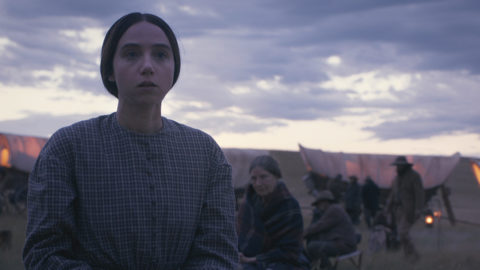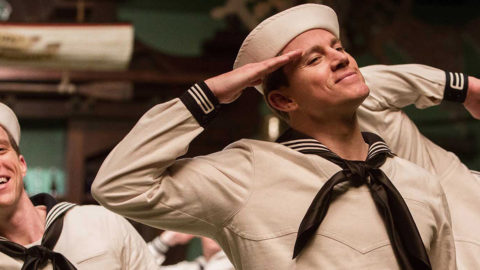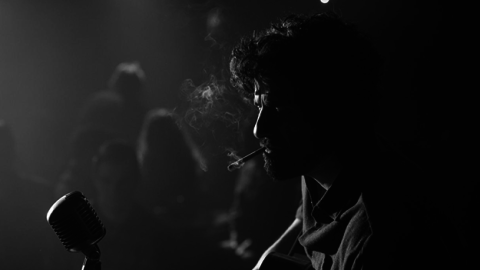Interview: Bruno Delbonnel
One of the most uncompromising and versatile cinematographers working today, Bruno Delbonnel resumed his collaboration with the Coen Brothers with the six-part Western anthology The Ballad of Buster Scruggs, shot over 10 weeks. At once ominous and farcical, the meticulously crafted film provides a rich window into Delbonnel’s artistry.
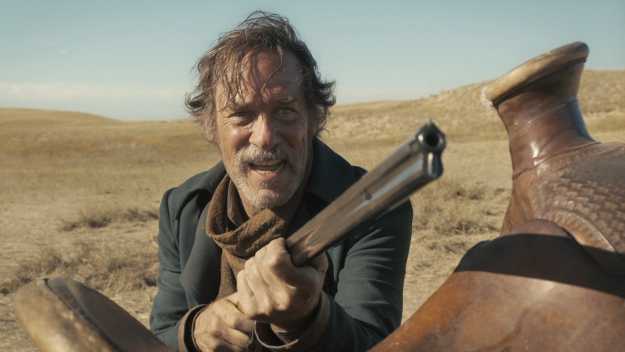
You ground every film’s cinematography in a main concept, which was the sadness of the New York winter for Inside Llewyn Davis. What was your underlying macro concept for The Ballad of Buster Scruggs and your micro concept for each of its visually and narratively distinct six chapters?
I didn’t have a main concept for The Ballad of Buster Scruggs because of its episodic nature. Our first question was precisely whether we should have an aesthetic difference between each chapter—a very big concern that we only resolved at the end, during the color grade. At the beginning, there was this desire to have six different universes. But the idea was not to give the impression that there were six different directors. In any case, the Coen Brothers’ writing is very specific and didn’t change in every segment. So the second question was: is this a whole or are these six short films? Ultimately, the visual motif of the book [which links the chapters] made it clear that it was a whole. Of course, The Ballad of Buster Scruggs deals with themes that constantly return in the Coen Brothers’ movies, like death and absurdity. So there was a sort of coherence in terms of subject matter. From that point on, we forgot all the cinematic references we could have: Once Upon a Time in the West, Shane, or The Searchers.
So you didn’t take into account the iconography of the Western genre?
The Western is a very typified, entirely American genre. When you show Monument Valley, it’s clear that it’s Monument Valley. How can you avoid comparisons with The Searchers or Stagecoach? Obviously, the references kept coming back, and at first, we took ownership of them, but then we said, “That makes no sense.” And what became interesting was to see what the stories themselves told. For instance, the [titular] first episode begins in Monument Valley, but it’s not the Monument Valley of The Searchers. It’s the Monument Valley of a singing cowboy, who is wearing white clothes and riding a white horse, and is absolutely ridiculous. So it became a sort of postcard Monument Valley, and the saloon became a saloon from a musical, not a moody one—it was meant to say, “Come on, it’s party time!”
Did you look at pulp magazines for inspiration?
No. For me, there were two obvious things. The first one was the American landscape, which is very typical. In France, we have very beautiful landscapes, but they are limited in size and scope, and their appearance changes along the way. In the United States, it’s the opposite. For instance, when we were shooting [the fifth episode, “The Girl Who Got Rattled”] in the Oregon Trail, in Nebraska, we found ourselves in 200-kilometer-long plains. And this idea of the immensity of the landscape was ever-present.
Landscapes are characters on their own in The Ballad of Buster Scruggs.
Exactly—until the last episode [“The Mortal Remains,” set almost entirely in a stagecoach], where there is no landscape left at all. It was scripted that the film would be framed as a book and that each chapter would begin with an illustration. So the big reference we had at the beginning was N.C. Wyeth, who was Andrew Wyeth’s father and a great illustrator who illustrated Western stories and Dickens’s writings, among others. He was really our key influence and kept popping back in our minds throughout the shoot. The composition of shots in The Ballad of Buster Scruggs always evokes illustrations, not paintings. And that’s also what I did with the lighting.
It’s true that there are camera set-ups in The Ballad of Buster Scruggs that would be unimaginable in Inside Llewyn Davis, such as that shot inside Buster Scruggs’s guitar or the canted angles of the Artist’s performance in “Meal Ticket.” Other unexpected and memorable elements were the swish pans of the Grand Canyon in the opening and the comic staccato staging of Scruggs’s murders. Did the Coen Brothers have a desire to broaden and vary their language?
These are all things that come from the brothers. I was quite against the idea of having canted angles because of the stylistic effect, but Joel and Ethan told me that was precisely what they were looking for. The Coen Brothers are filmmakers with a real language, and they work with that language. I don’t know what their collaboration with Roger Deakins is like, but in my case, they show me shot lists and storyboards, and we discuss them together.
Did you participate in the visual breakdown of scenes?
No. [Joel and Ethan] do the breakdown themselves, then they ask me what I think of it and whether I have better ideas or not. But on this film, we worked on the breakdown of a few segments together. So we would meet every day for four or five hours to go over the script and map it out visually.
Did you stage Scruggs’s murders together?
That’s all the Coen Brothers. For instance, when I was pre-lighting the saloon scene in which Scruggs smacks the table, they came to see me in the afternoon and said, “Oh no, you’re going the wrong way here. It shouldn’t be dark, but quite the opposite. It should be party time.” Ethan was particularly insistent on that. He said it was a ridiculous situation and the lighting should be very bright, like in a ’50s musical. They encouraged me not to be afraid of going all the way, and made it clear that doing it like Heaven’s Gate would be a mistake. So everything in that scene revolves around that idea, which is very much felt in the framing. That is to say that when Scruggs smacks the table, it was clear that we wouldn’t be doing close-ups. That moment is pure pulp, so we had to own it completely. And that was already obvious to us when we were shooting the opening in the Grand Canyon, with a very saturated look and ridiculous compositions. Therefore, we had to continue on that path and push things further in the saloon. So we went even further when Scruggs leaves to fight the Kid, and had a completely postcard-like color palette there: shiny blue for the sky, white for Scruggs, and red for the saloon.
We were talking before about the personification of landscapes, and I wanted to ask how you approached “All Gold Canyon,” the chapter that epitomizes this idea.
That chapter is about man’s appearance in nature and the way he destroys what was initially a paradise on earth. I find that what’s important there is less the story itself, but the motif of the animals, which are present at the beginning, leave when [the Prospector] arrives, and come back after he leaves. When we were shooting, the idea was to do it almost like National Geographic. We had an absolutely sublime setting in Colorado, and I wanted to push it even further toward a postcard look. But then I thought it might be better to remain more simple and let nature speak for itself. And we were lucky to shoot at nice hours with a magnificent light.
Were the episodes filmed in chronological order?
For purely logistical reasons, no. We started in New Mexico, with the first episode and the one with James Franco [“Near Algodones”]. Then we went to Colorado for the one with Tom Waits [“All Gold Canyon”], came back to New Mexico to shoot the stagecoach [“The Mortal Remains”] in a studio, and finished with the Oregon Trail in Nebraska [“The Gal Who Got Rattled”].
What was the average shooting time of each?
We shot for ten weeks in total. The one with James Franco was the quickest and didn’t take more than five or six days. The Oregon Trail was the most complicated and lasted three weeks. As for the stagecoach, it was about four days.
One striking aspect of the film is the transition from the naturalistic “The Gal Who Got Rattled” to the artificial and expressionist “The Mortal Remains,” which also marks a shift from exterior to interior. How did you tackle the lighting design in “The Mortal Remains” and the constraint of sculpting the drama exclusively through faces in a confined space?
What I find really interesting in the last chapter, and which people don’t tend to notice, is that it contains references to all the previous chapters.
It’s a sort of descent into hell.
Completely. But the problem there was purely practical: how can you have five people in a stagecoach for 20 minutes and avoid portraying them as talking heads? So we rendered the scene totally artificial by suggesting a sunset, and an extremely rapid one at that. In the script, the whole trip took place at night, but I thought, “I have nothing to light that.” Therefore, doing the sunset was a way of justifying [the scene], and raised the question of the dullness of talking heads.
The sunset creates an effect of temporal compression.
If we hadn’t done it, the scene would have been a linear 20-minute dialogue. The characters could have been a mile away from the city where they were going, and their conversation would have played out in real time. So the sunset added a very dramatic element. Ultimately, that scene was the most difficult one for me to execute, because it had to be timed very carefully. Everything was handled on a computer in order to time the trajectory of the sun and the moon, which has a powerful presence. It was very mathematical, and the important thing for Joel and Ethan was that it’s already nighttime when the Frenchman (Saul Rubinek) leans out the window to ask the driver to stop. So the whole thing becomes even more artificial there, and that raised another question: what happens for the remaining nine minutes? Aren’t we going to be bored? But at the same time, the situation shifted through the dialogue, because at the beginning, the action is focused on the three characters [the Lady, the Frenchman, and the Trapper], and then we move onto Brendan Gleeson and Jonjo O’Neill [the Irishman and the Englishman]. That transition worked, and allowed us to arrive at the image of the hotel, which is a real reference to The Night of the Hunter. We decided that was the aesthetic of the hotel and really went for it.
That shot also reminded me of Roger Corman’s adaptation of Poe’s “The Fall of the House of Usher.” There was somewhat of a gothic quality to it…
I don’t know if you can call it gothic. In any case, that wasn’t our reference. The two barns in the background are a clear allusion to The Night of the Hunter, with the driver seen in silhouette on his horse. So it was a very stylized visual reference, and the set was also rendered in false perspective. It’s an extremely beautiful set, and there’s no green-screen or anything. The trees in the background were painted, and the bridge was a miniature one.
So you had your Red Desert moment there. [Antonioni manipulated the environment on his first color film by painting trees, among other props.]
Yes, it was terrific.
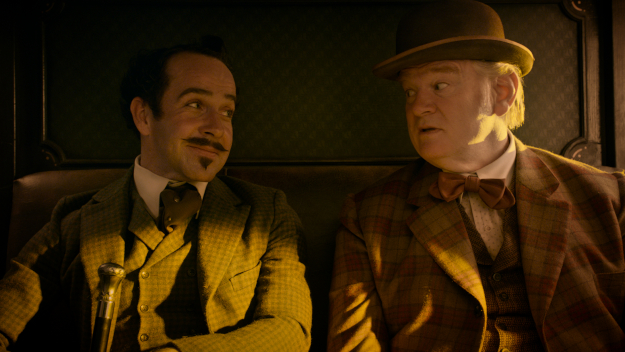
You studied philosophy before transitioning to filmmaking. Do you follow in the footsteps of someone like Vittorio Storaro by drawing inspiration from philosophical concepts in your approach to cinematography?
No, I don’t think so. I don’t have the ambition to be a philosopher. For me, it’s just an education that stays. I’m still interested in philosophy and read it. And Ethan Coen also studied philosophy at Princeton, so we talk about it from time to time and have a good laugh. What interests me more is the history of arts, and how cinema has gradually become an art form. I try to grab things everywhere. Talking about rhythm is talking about cinema. Sculpture is rhythm as much as it is volume, so I’m interested in how sculptors approach those. It’s the same for musicians. After all, film is music. And you can ask yourself whether it’s more interesting to adopt the Western chromatic scale or the Japanese one. For instance, I am not familiar with the chromatic scale of Indian music, but I know it’s very different and not based on the same perception at all. So it’s interesting to ask yourself how you can translate that into images and lighting, and how light can also be a chromatic form in the musical sense of the word. What would be the key of light, but also of composition? How can you give yourself a rule that would make a frame into a completely abstract form? Those kinds of questions interest me. Afterward, I don’t know if I succeed in applying them, but I am not a person who improvises. I just can’t understand that approach. That’s not the way the Coen Brothers work either. But at the end of the day, there is no good or bad method, and everybody uses the method that suits them.
How has your relationship with the Coen Brothers evolved throughout the years?
Let’s say I am less afraid of them now. You know, they are extremely generous, fabulous human beings, who work with a family. The sound engineer has done all their films since Blood Simple, and that’s absolutely rare. So they try to have people who bring joy to their shoots, and those people also happen to be wonderful technicians. The Coen Brothers’ sets are not battlefields, but very pleasant places. Ethan and Joel are extremely accessible, and everybody, including a third assistant, can ask them whatever question. But they expect in return that we also have answers to their questions and contributions to make. I remember one time, on the set of Inside Llewyn Davis, I said to Joel, “I don’t really like this shot. Does it bother you if I change it?” And he answered, “Not at all. On the contrary, you’re here for that.” So now I feel even more at ease to suggest things, because I know that’s what they expect from me.
How immersed were you in America’s current political context while shooting The Ballad of Buster Scruggs?
At a screening in Paris, somebody said, “The Coen Brothers have mistreated the Indians. It’s a retrograde vision.” And I said, “But that’s not at all the film’s subject. In fact, it was the reality of the time.” That is to say that when people did the Oregon Trail, they went through territories that belonged to the Indians, and the Indians were not pleased and wanted to kill them. So I don’t think there is a political dimension to The Ballad of Buster Scruggs, as there was one to a film like Little Big Man. I’m not sure either that the Coen Brothers are directors who deal with politics. But retrospectively, as a Parisian shooting Westerns in the depths of America, it’s true that I’ve started to have an understanding of the Second Amendment. The Oregon Trail is a relatively recent story; it was only a century and a half ago. A century and a half ago in France, there were already laws that dated back to Charlemagne. So as far as [the Oregon Trail] is concerned, you think, “They left Missouri and travelled 300 kilometers along unknown territories to reach Oregon.” And you understand the need to carry a weapon in those circumstances. It was to protect themselves, not only against Indians, but also against the people who travelled with them and were glad to rob them. And that lasted until the First World War. That’s why it was interesting for me to reflect on this aspect of American history, even though I’m completely against the NRA and all those things—I find it revolting.
In fact, when we were shooting in Nebraska, there was a manufacturer of signs and billboards. And on the edge of the national road that led to Dakota, he had put up political signs, so to speak. He had made a three-meter-long billboard with pictures of Washington, Lincoln, Reagan, and Trump, next to each other. And underneath Trump, he had written something like, “Only history will tell.” The people who drove on the road passed by this billboard, and the manufacturer changed it every six months with signs that said, “The only thing we need are the ten amendments, the constitution, the right to have a weapon, etc.” So I went to see him one Saturday to ask what this was all about, and he replied, “I’m not for the NRA, but for the United States Constitution and the rights it grants to American citizens.” In France, it’s forbidden to wear a weapon for two centuries. So the whole situation was fascinating to me, even though I felt very disconnected from it deep down. And in a certain sense, that’s also the story of the Coen Brothers, who come from Minnesota. They’re very educated, their parents were intellectuals, but they still come from the depths of America, and that’s their reality. They’re American filmmakers with a history, and they talk about that history in the tradition of their national cinema, but with excessively intelligent and cultivated influences that originate from the entire world.
Why don’t you work in France anymore?
I live in Paris, but the last film I did in France was A Very Long Engagement, in 2004. It’s not out of personal choice, but rather the way that things have unfolded for me. I just happened to get more interesting offers in America than in France. So even though I had a family in France, I thought, “Why not?” Now, there are moments when I say to myself it would be nice to make a film in France, because being away for so long doesn’t make things easy family-wise. But at the same time, I can’t complain, because I was shooting The Ballad of Buster Scruggs with the Coen Brothers last summer, and it was terrific.
You have a highly identifiable visual style regardless of the directors you work with. I’ve read that Henri Alekan introduced you to the craft of cinematography, and it’s interesting because he’s played a similarly formative role in the filmmaking journey of Agnès Godard, whom I love and who also employs a very palpable, consistent language. So I was wondering whether Alekan’s mentorship is partly responsible for your aesthetic integrity.
I met Henri Alekan because he shot a short film that I directed. But I can’t stand Beauty and the Beast [which Alekan shot]. [Laughter] I hate Cocteau: he’s a bad writer and a bad director. I can be quite loquacious when it comes to Cocteau—I find him to be a total usurper. There are magnificent shots in Beauty and the Beast, but it’s an unbearable film. However, Henri was a great master of black-and-white cinematography. And in fact, it’s not so much his mentorship but his passion that influenced me. When I directed that short, I realized that I was spending more time talking to him than to my actors and producer, and that the whole production aspect of filmmaking didn’t interest me a bit. So I came to the conclusion that being a director was an extremely difficult job because of its logistical dimension. As cinematographers, we don’t have to deal with any of that. When you make a bad film, people say it’s bad because of the director. When you make a good one, they say it’s good because of the director, and that the director of photography also did a very good job. But they never say it’s a great film with terrible lighting by the director of photography. It’s very rare for people to say that a director of photography has done very bad work. Film reviews either don’t mention us, or say we did good work. So we are like oil moguls, whereas directors really suffer from criticism. When Scorsese won an Oscar for The Departed, I heard people say, “Yes, he has won the Oscar, but it’s not a really good film.” And I wanted to say, “You’re crazy. It’s a terrific film. And yes, he has made other films that were even more terrific, but he’s still an incredible director who should have won an Oscar long ago.
But in terms of visual style, I am absolutely not conscious of having one. I don’t think it’s false modesty; it’s just my vision of the world. I feel like when I did the first chapter of The Ballad of Buster Scruggs, I simply did what I was seeing. It’s not an exercise in style, but rather the way I see the world and colors. For instance, everybody says that [“The Mortal Remains”] is very blue, but I say, “Maybe there’s some blue, but there’s also gray and black, and a very dirty black for that matter.” So I really don’t have the impression of having a style. I think there is a universe between Amélie and The Ballad of Buster Scruggs, as much as there is a universe between Amélie and Harry Potter and the Half-Blood Prince, or Sokurov’s Faust. On Faust, I just felt that was the way the film had to be done, and it obviously would have been very different had another director of photography shot it.
To be honest, I don’t understand the idea of style, because there is something very particular about cinema, which is the fact that it’s teamwork. There are things that come from the director, just like there are things that come from the production or costume designer, who are amazing people and also have a say on the film’s style. So what is fascinating in cinema is this meeting of sensibilities, which can happen or not. But when it happens, when everybody, including the actors, is on the same wavelength, there is a sort of obviousness to the film. In the end, what people watch are the actors, and we, cinematographers, are just an element that is as important as them. It’s like what Jean Renoir used to say: “A film is 50 percent the script, 50 percent the actors, 50 percent the lighting, 50 percent the set, etc.” And he was absolutely right, because at the end of the day, all those elements are equal. So even though I don’t like the word, my “style” is linked to the quality of the set design as much as it is linked to that of the costumes and the make-up. I don’t know what I would have done on Darkest Hour if I had bad make-up. We had an extraordinary hair and make-up artist who transformed Gary [Oldman] into Churchill, and I wouldn’t have been able to hide it with my lighting had the work been bad. So it’s precisely this collaboration that is magnificent in cinema, like in architecture and music. When a composer writes a symphony, all the musicians in the orchestra have to be together. If a violinist doesn’t play with the others, you hear it, and everything collapses. It’s the same in architecture: if the elements of the facade are not well chosen, the facade looks horrible even if it was well drawn and conceived. But there’s also a moment when the film starts speaking for itself and rebelling. It becomes a sort of living organism, an alien; it takes you somewhere, and you have to manage to put it back on track. You have to understand where the film wants to go, and you have to hear and respect that. My experience with Sokurov was magnificent, because we were taken somewhere we didn’t expect to go.
The idea is to begin the process intellectually and then to let your gut feeling take over.
Exactly. The images speak to you, and you have sensations. I remember leaving the shoot of Faust completely worn out. I was emotionally exhausted, because it was a very intense story. In a way, I felt like the film had gone through me, like a cannonball.
In that respect, being a cinematographer is like being a performer.
Yes, like being a choreographer or a dancer. It’s a completely physical experience. And that’s why I have trouble understanding sometimes what film students want to know. They talk about storyboards, and I tell them, “But Sokurov also did storyboards, just like the Coen Brothers did storyboards for Inside Llewyn Davis and The Ballad of Buster Scruggs.” However, storyboards are not the Bible, and we are not fundamentalists following them blindly. On Faust, we took the storyboards and tore them apart, saying, “We only have the story now.” Because we did the storyboards, we knew more or less where we wanted the film to go, but it was clear that the film would try to take us somewhere else. So we learned something from the film and could go further thanks to that.
Translated by Yonca Talu.
Yonca Talu is a filmmaker living in Paris. She grew up in Istanbul and graduated from NYU Tisch.



